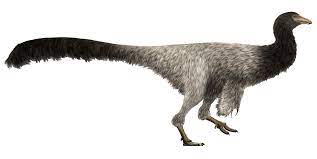
Garudimimus Dinosaur is a genus of ornithomimid dinosaur dating back to the early Cretaceous. It was first discovered in the Bayan Shireh Formation, Inner Mongolia, China in 1981. The sample is composed of a partial skeleton, including a nearly complete skull, portions of the neck and back, portions of the arms and legs, and including some of the teeth. The Garudimimus reach about 1.5 metres in length and were bipedal, meaning they stood and moved on two legs. These were active, lightly-built animals, probably quite fast and agile. They are characterized by a long head, a relatively long neck, a lightweight body, and well-developed arms with long hands.
Garudimimus had many of the features that are typical of ornithomimids. Its most prominent feature is its long, slender skull, which is lightly built and more akin to those of avian animals. The skull also has a distinctive crest. The thickness of the skull's facial bones suggests that it may have had a beak at the front of its jaws. The most striking feature of this dinosaur is its unusually large forearms. This vast upper arm and hand size implies a significant degree of dexterity, and paleontologists believe the Garudimimus used these appendages to forage for food. The rest of the skeleton of the Garudimimus are relatively incompletely known.
Garudimimus Facts :
| Name: | Garudimimus Dinosaurs |
| Size: | 10 meters |
| Main Facts: | The upper arm bones (humeri) are especially wide, indicating powerful forelimbs with long fingers. |
The pelvic bones are particularly small, likely indicating that it was not a fast runner. The feet had sharply curved claws, another evidence of foraging behavior. The bones of the neck are incompletely preserved, but it is likely that it was very flexible and could have allowed its head to reach down and pick up food from the ground. Although it was likely a terrestrial dinosaur, Garudimimus may have had strong propense to staying near water, as the fossil material found was around a large, freshwater lake.
Due to its diet, it may have had a similar niche to modern wading birds, like waterfowl. It probably ate small, soft prey, such as insects and plants. Overall, Garudimimus was a unique dinosaur, one of the best-known members of the ornithomimid theropod family. Its unusual skeletal anatomy and range of behavioural adaptations indicate that it was an active, fast-moving, omnivorous creature that was well adapted for living in an aquatic environment. Its long and somewhat flexible neck may have allowed it to reach down and forage among aquatic plants for small prey items, or it may have been a specialized filter-feeder. Whatever the case may be, it was certainly one of the most interesting dinosaurs of its time.